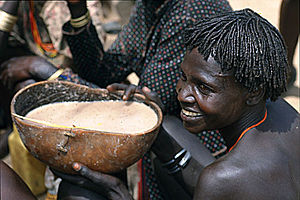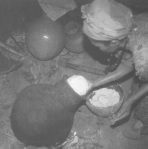THE ETHIOPIAN HONEY WINE t’ej is easy to find in Ethiopian restaurants: Nearly a dozen wineries in the U.S. make it, most restaurants with liquor licenses sell it, and some places even sell homemade t’ej, always in contravention to local laws, whose enforcers either look the other way or simply haven’t noticed. There’s a market in D.C. with no liquor license that sells homebrew, but you have to be able to read Amharic to understand the sign in the window that advertises it.
Less easy to find is t’alla (sometimes written t’ella, tella or tela), the traditional Ethiopian homemade beer that’s called farso in Afaan Oromo and suwa in Tigrinya. In fact, you can’t find it: In my visits to many Ethiopian restaurants, I’ve only found one place that sold it, and that lovely little restaurant has since closed.
The recipe for t’ej is simple: Mix one part honey to three parts water, put in some stems and branches of gesho (a unique Ethiopian species of buckthorn), and let it ferment for five or six weeks, removing the gesho after two weeks. It’s that easy, more or less.
Not t’alla. I’ve tried it twice, and it’s worked once. The second time was a big horrible sopping mess.
Berhe Tekle Adhanom identifies three different types of t’alla: zilel, made with barley, maize, sorghum or other similar grains; corafe, made with lightly roasted barley; and lifter, made with well-roasted barley or sorghum to give you a darker finished product.
“T’alla is believed to be over 10,000 years old,” he writes, engaging more in lore than documented history. “Although no one knows its exact origins, some agricultural historians believe that the first t’alla may have been produced accidentally when a stash of grain was soaked by rain and then warmed by the sun. If this mixture were spontaneously fermented by wild, airborne yeast which thrives in just these warm, moist conditions t’alla would have been produced.”
The ingredients of t’alla aren’t necessarily hard to find: You’ll need barley flour, wheat “berries” (i.e., whole wheat kernels), and gesho leaves or powder, as opposed to the sticks and branches used for t’ej. You put the gesho into water for several days, put the wheat berries into a different container of water for several days and let them sprout, bake the sprouting berries until they get a bit crispy, add the wheat berries to the water with the gesho, turn the barley flour into a batter, bake it until it begins to dry a little, crumble it up, add it to the other stuff in the liquid, and then, hope it ferments and turns into beer and not into – well, a big horrible sopping mess.
By the way, the apostrophe in the name t’alla
represents the explosive “t” consonant in Amharic, and it’s pronounced with a little snap of the tongue against the roof of the mouth. But it’s just as often written in English without the apostrophe. In Ethiopia, people will gather at a t’alla bet, or “t’alla house,” to drink and socialize.
I’ve enjoyed t’alla at only one restaurant, the now-closed Gori Café in Washington, D.C. Its owner, Yonas Chalka, drove a cab for many years and used some of his savings to open a very small, very homey restaurant, located a few blocks off the busy cluster of Ethiopian and Eritrean restaurants along U Street NW. I don’t know how small places like that can ever hope to survive: If Yonas had filled every seat, all 10 of them, from opening until closing, all day every day, would he have earned enough money to make the restaurant his livelihood? Fortunately, Yonas didn’t give up his day job, and his restaurant lasted for about a year.
I enjoy eating at small places like that and talking with the owners, and I especially liked Gori Café and Yonas because he was Oromo, a rarity among Ethiopian restaurant owners in the United States. His restaurant’s name comes from an Afaan Oromo word that means “come in.” In my book Mesob Across America: Ethiopian Food in the U.S.A., I explore the cultural conflict between Oromos and Amharis and talk with some Oromos who own restaurants here.
On my first visit to Gori Café, when I talked with Yonas, he told me that he sometimes had t’alla on the weekends. I returned for dinner on Saturday night and treated myself to a bottle. He didn’t sell it by the glass, which was no problem for the solo diner: It wasn’t too alcoholic, and drinking a full bottle got you about as buzzed as two glasses of wine. It was the color of tea or a dark amber t’ej, a little sweet (like cider) and a little grainy (from the barley), with effervescent bubbles. You could taste the malt of the hops, like a microbrew, and the further down the bottle you got, the thicker and chewer it became, so you had to give your bottle a gentle shake to distribute the settled ingredients.
Yonas wouldn’t say who made his t’alla, but you could tell that it didn’t come from a brewery: He served it in recycled wine bottles, sometimes with the original label, with no cork or cap, just a piece of aluminum foil on top to keep it from spilling. All he would say is that some Oromo people in the community made it in their homes. It was a unique treat in a city with so many Ethiopian restaurant choices.
But now Gori Café is gone, and I haven’t yet perfected the brewing of t’alla at home. My one good batch tasted enough like the stuff I had at Gori Café for me to say that it can be done. I just wouldn’t recommend that you plan a dinner party around it.
Harry Kloman
University of Pittsburgh
Check out this vivid YouTube video of t’alla preparation in Ethiopia.






Leave a comment